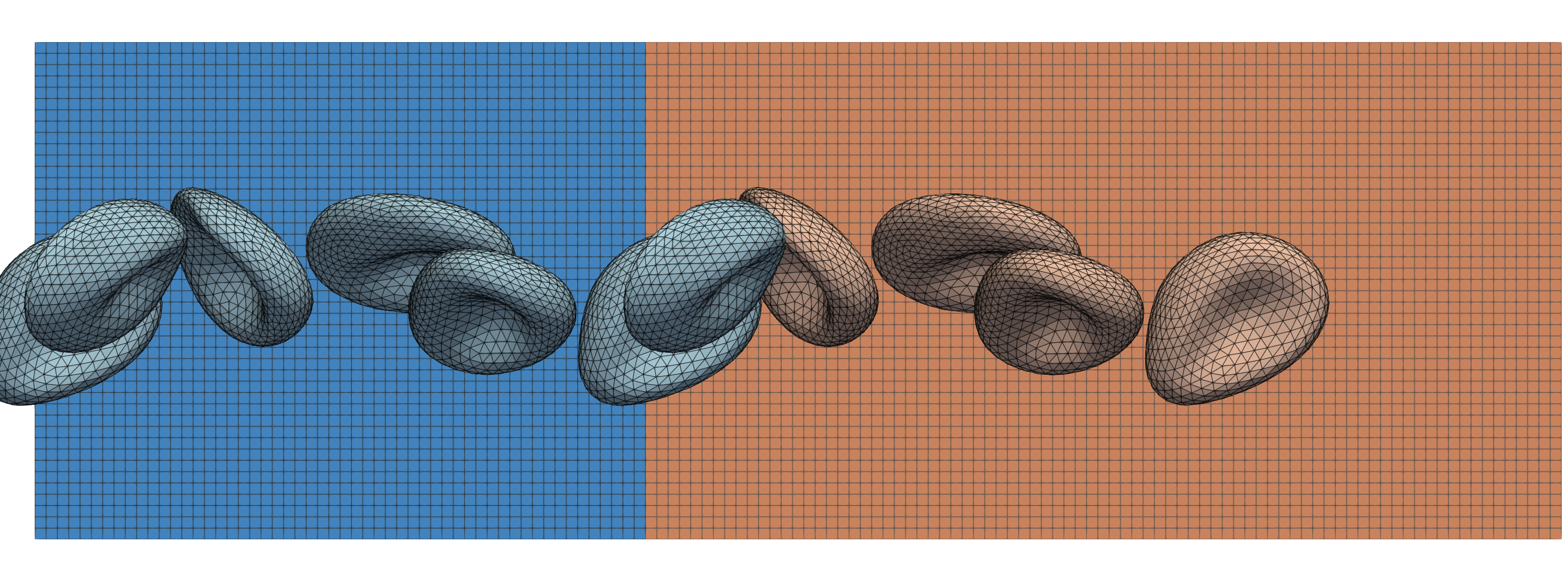Pipe flow with periodic inflow¶
The example in examples/pipeflow_with_preinlet provides an extension of the
pipe flow example with the advanced
pre-inlet boundary condition as discussed in the next section.
After compilation, the example can be run as:
# run the simulation from the `examples/pipeflow_with_preinlet` directory
mpirun -n 2 ./pipeflow_with_preinlet config.xml
# generate Paraview compatible output files
../../scripts/batchPostProcess.sh
Pre-inlet boundary condition¶
The pre-inlet is one of the advanced boundary conditions in HemoCell and it provides a mean to generate a periodic influx of particles into the main simulation domain. This is of specific interest when normal periodicity on the original simulation domain is not adequate. For instance, consider the following scenario:
A complex simulation domain might have a large fluid area that slowly fills up with particles as the simulation progresses. To simulate such behaviour, we would like to introduce a continuous flow of particles into the simulation domain, without initially packing the full domain with particles. In such a scenario, the pre-inlet will provide a continuous, periodic influx of particles from a small section of packed domain.
A simulation domain might not have matching inlet and outlets to specify periodic conditions, e.g. when the inlet and outlet have different non-matching diameters. In this case, the pre-inlet can be used to provide a constant influx of particles at the inlet, where the particles reaching the outlet are removed from the simulation.
The pipe flow scenario using the pre-inlet is visualised in the following sequence of images. The total domain contains two regions: the pre-inlet (blue, left) and the main simulation domain (orange, right). At first, the particles, in this case red blood cells, are initialised in the pre-inlet domain.

A two-dimensional projection of the total domain consisting of the periodic pre-inlet (blue, left) and the non-periodic main simulation domain (orange, right). The pre-inlet domain is seeded with a number of red blood cells at the start of the simulation.¶
As the simulation progresses, the RBCs in the pre-inlet approach the main simulation domain. At this moment in time, these RBCs are copied into the main simulation domain as well as repeated again at the inlet of the pre-inlet. Notice how the RBCs near the boundary change from blue (pre-inlet) to orange (main domain) as they cross this boundary. Additionally, you can see the cells near the boundary reappear at the pre-inlet’s inlet.

After a number of iterations the pre-inlet starts to provide the main simulation domain with a periodic influx of red blood cells. As these cells cross the boundary between both domains a copy is transferred to the main simulation domain and the cells is repeated at the pre-inlet’s inlet. Notice how the cells crossing this border go from blue to orange. Additionally, you can see the cells at this boundary repeated at the pre-inlet’s inlet.¶
After numerous iterations the pre-inlet will achieve a quasi-steady-state, providing a continuous stream of particles to the main simulation domain.
Note
The distribution of these particles originate from the original positioning of particles within the pre-inlet. Thus, to achieve a larger number of particles flowing into the main simulation domain, the pre-inlet should be packed more densely at the start (see packCells).

After more iterations the pre-inlet keeps seeding the main simulation domain with new particles, all originating from a single initial positioning.¶
Conceptually, the pre-inlet works as follows: the pre-inlet is attached to an original inlet of a simulation domain of interest. The pre-inlet is then subjected to periodic boundary conditions on its inlet and outlet surface. At the start, we seed the pre-inlet with a specific arrangement of particles (red blood cells, platelets, etc) as generated by packCells.
During simulation, the particles will flow through the pre-inlet and cross the interface between the pre-inlet and the main simulation domain. At that moment, the specific particle is copied to the main domain as well as to the inlet of the pre-inlet (due to its periodic boundaries). This ensures that the original packing of the pre-inlet remains (approximately) constant as the simulation is ongoing, while simultaneously introducing new particles into the simulation domain.
Note
Although the original cell positioning can be purely aimed at populating the pre-inlet region of the domain, there is of course no limitation to pack the full domain. In that case, the cells that are present in the pre-inlet at initialisation will be subjected to the periodic behaviour of the pre-inlet and are continuously introduced into the main simulation domain. The other particles, i.e. the ones in the main domain, are not effected by the presence of the pre-inlet.
Configuration¶
For basic configuration of the pipe flow, this example follows the same configuration settings as the original pipe flow example, as discussed here. However, there are some pre-inlet specific parameters that can be modified:
<preInlet><parameters><lengthN>: the length of the pre-inlet in lattice units. This indicates the length of the pre-inlet that is inserted before the main domain.
Note
Compared to the original pipe flow example, the packing is now aimed at the pre-inlet region of the domain. This might require to shift the original placements of the cells accordingly.
